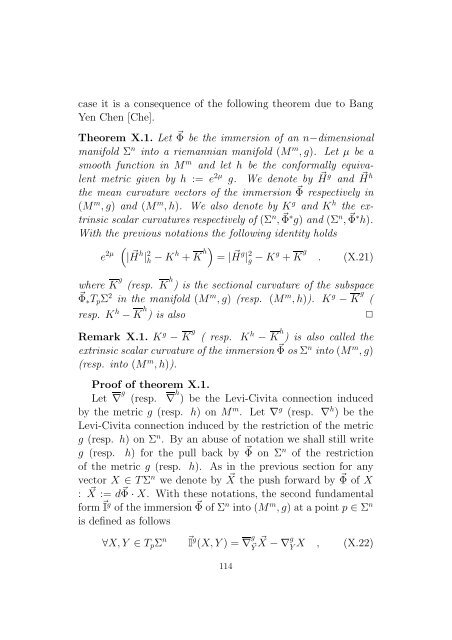Conformally Invariant Variational Problems. - SAM
Conformally Invariant Variational Problems. - SAM
Conformally Invariant Variational Problems. - SAM
You also want an ePaper? Increase the reach of your titles
YUMPU automatically turns print PDFs into web optimized ePapers that Google loves.
case it is a consequence of the following theorem due to Bang<br />
Yen Chen [Che].<br />
Theorem X.1. Let ⃗ Φ be the immersion of an n−dimensional<br />
manifold Σ n into a riemannian manifold (M m ,g). Let µ be a<br />
smooth function in M m and let h be the conformally equivalent<br />
metric given by h := e 2µ g. We denote by ⃗ H g and ⃗ H h<br />
the mean curvature vectors of the immersion ⃗ Φ respectively in<br />
(M m ,g) and (M m ,h). We also denote by K g and K h the extrinsic<br />
scalar curvatures respectively of (Σ n , ⃗ Φ ∗ g) and (Σ n , ⃗ Φ ∗ h).<br />
With the previous notations the following identity holds<br />
e 2µ ( | ⃗ H h | 2 h −Kh +K h) = | ⃗ H g | 2 g −Kg +K g . (X.21)<br />
where K g (resp. K h ) is the sectional curvature of the subspace<br />
⃗Φ ∗ T p Σ 2 in the manifold (M m ,g) (resp. (M m ,h)). K g − K g (<br />
resp. K h −K h ) is also<br />
✷<br />
Remark X.1. K g − K g ( resp. K h − K h ) is also called the<br />
extrinsic scalarcurvatureof the immersion ⃗ Φ os Σ n into (M m ,g)<br />
(resp. into (M m ,h)).<br />
Proof of theorem X.1.<br />
Let ∇ g (resp. ∇ h ) be the Levi-Civita connection induced<br />
by the metric g (resp. h) on M m . Let ∇ g (resp. ∇ h ) be the<br />
Levi-Civita connection induced by the restriction of the metric<br />
g (resp. h) on Σ n . By an abuse of notation we shall still write<br />
g (resp. h) for the pull back by ⃗ Φ on Σ n of the restriction<br />
of the metric g (resp. h). As in the previous section for any<br />
vector X ∈ TΣ n we denote by ⃗ X the push forward by ⃗ Φ of X<br />
: ⃗ X := d ⃗ Φ·X. With these notations, the second fundamental<br />
form ⃗ I g of the immersion ⃗ Φ of Σ n into (M m ,g) at a point p ∈ Σ n<br />
is defined as follows<br />
∀X,Y ∈ T p Σ n<br />
⃗ I g (X,Y) = ∇ g ⃗ Y<br />
⃗ X −∇<br />
g<br />
Y X ,<br />
114<br />
(X.22)
















